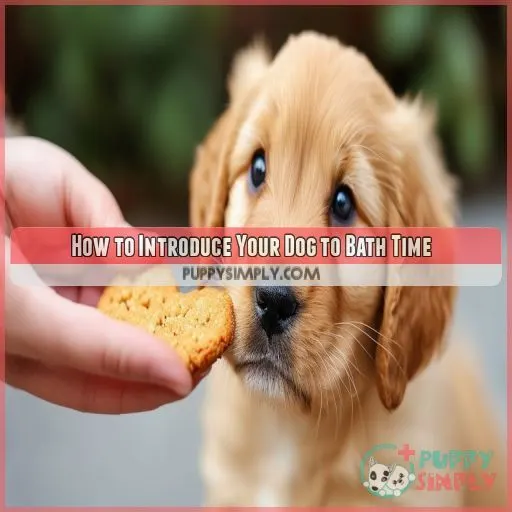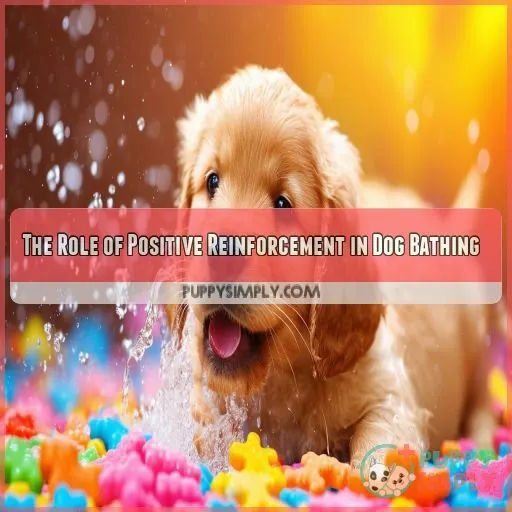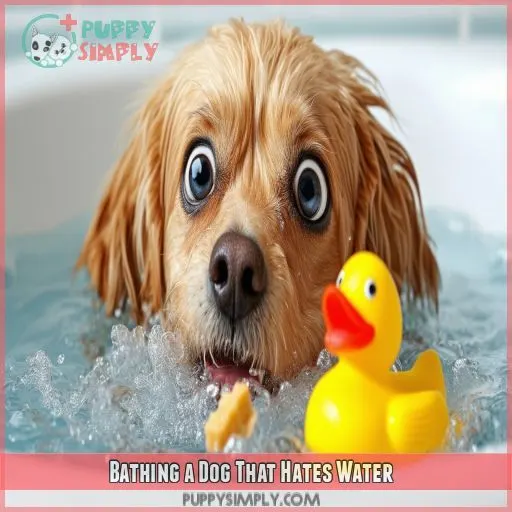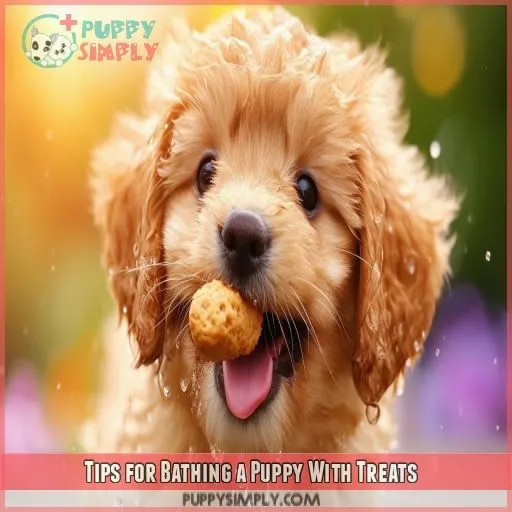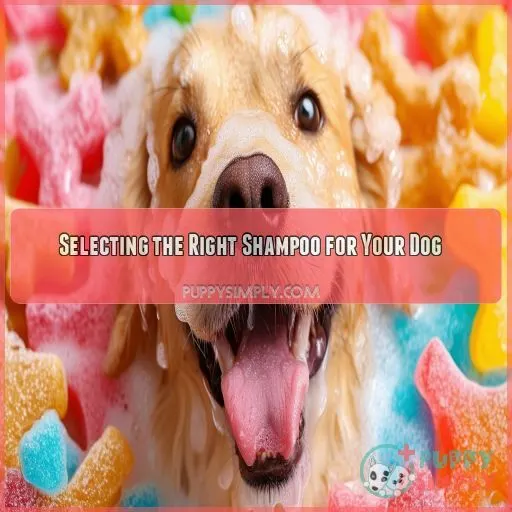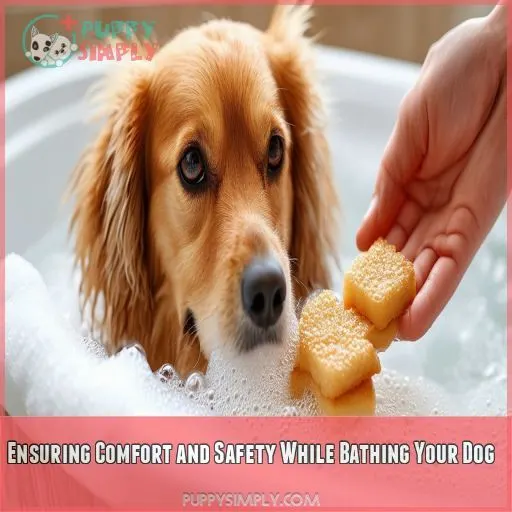This site is supported by our readers. We may earn a commission, at no cost to you, if you purchase through links.
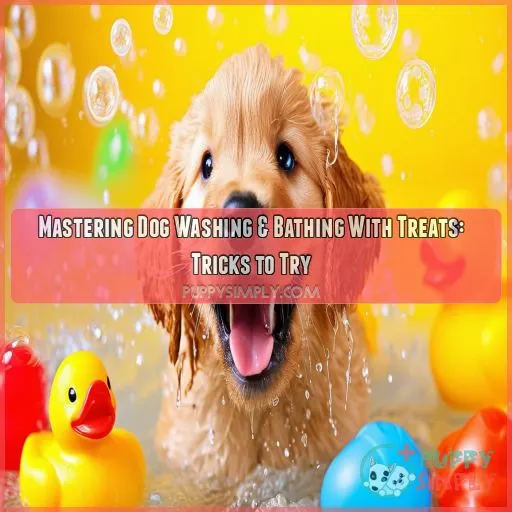
It’s time to master the art of dog washing and bathing with treats!
In this article, we’ll explore tricks to make bath time a breeze, from introducing your dog to the process positively to selecting the right shampoo for their coat type.
We’ll also tackle the challenges of bathing a puppy or a dog that hates water.
Table Of Contents
- Key Takeaways
- How to Introduce Your Dog to Bath Time
- The Role of Positive Reinforcement in Dog Bathing
- Bathing a Dog That Hates Water
- Tips for Bathing a Puppy With Treats
- Selecting the Right Shampoo for Your Dog
- Ensuring Comfort and Safety While Bathing Your Dog
- Frequently Asked Questions (FAQs)
- What not to do when washing a dog?
- What is the proper way to wash a dog?
- What can I use in place of dog shampoo?
- How do you wash a dog that has never been washed?
- How often should I bathe my dog?
- How do I prevent my dogs ears from getting wet?
- Can I use human shampoo on my dog?
- How can I make bath time less stressful for my dog?
- Whats the best way to dry my dog after a bath?
- Conclusion
Key Takeaways
- Tired dogs are less stressed during bath time, so exercise or play with your pup before you start.
- positive reinforcement with treats and praise is key to helping your dog associate bath time with rewards.
- Use lukewarm water and avoid getting shampoo in their eyes or water in their ears to ensure comfort and safety.
- Choose the right shampoo based on your dog’s coat type and opt for natural, gentle options if they have sensitive skin.
How to Introduce Your Dog to Bath Time
Introducing your dog to bath time can be a tricky business, but with a bit of preparation and the right approach, you can make it a positive and enjoyable experience for both of you.
Before you even turn on the faucet, tire your dog out with some exercise or playtime. This will help them associate bath time with fun and reduce any stress or anxiety they may feel about the process.
When it’s time to start, gather your supplies: shampoo, towels, a cup for rinsing, and some water-safe toys. Prepare the bath area by filling the tub with warm water and placing the toys inside. You want to create a welcoming and comfortable environment that doesn’t trigger your dog’s water anxiety.
Now, it’s time to gently guide your dog into the tub. Use a calm and reassuring voice, offering plenty of encouragement and praise. Remember, you’re a team tackling this together!
With these steps, you’ll be well on your way to mastering the art of dog washing and helping your furry friend feel relaxed and refreshed.
The Role of Positive Reinforcement in Dog Bathing
Positive reinforcement is a powerful tool when it comes to dog bathing. By using treats and praise, you can transform your dog’s attitude about bath time and create a positive association. Dogs are motivated by rewards, so incorporating treats into their bathing routine can make a huge difference in their behavior.
Start by rewarding your dog for calm behavior during the bath preparation. This helps to establish a positive mindset before they even enter the tub. As you gently ease your dog into the water, continue to offer treats and encouragement. This will help your dog feel safe and understand that bath time is a positive, rewarding experience.
The key is to be patient and consistent. Over time, with positive reinforcement, your dog will begin to associate bath time with treats and praise, leading to a more enjoyable experience for both of you. Remember, it’s important to use dog-specific shampoo and avoid harsh chemicals to make sure a comfortable and rewarding bath time for your furry friend.
Bathing a Dog That Hates Water
Some dogs dislike water, so you’ll need to make bath time a positive experience.
Use positive reinforcement and treats to encourage good behavior.
Be patient, as dogs can feel anxious during their first bath.
Place a non-slip mat in the tub to make them feel more secure.
Keep the room warm and play relaxing music to create a calm environment.
Rewarding your dog helps them associate bath time with pleasant experiences.
Tips for Bathing a Puppy With Treats
Bathing a puppy for the first time can be a challenging task, but with treats and a positive attitude, you can make it a fun and rewarding experience for both of you. Here are some tips to help you master the art of puppy bath time:
- Use puppy-safe shampoo: Opt for a mild, gentle formula designed specifically for puppies. Avoid harsh chemicals that could irritate their delicate skin.
- Make it a positive experience: Just like with adult dogs, use positive reinforcement techniques to associate bath time with treats and praise. Be patient, gentle, and understanding, as puppies can be easily overwhelmed by new experiences.
- Keep the water warm: Avoid hot or cold water, which can be uncomfortable or even scary for a young pup. Warm water will help your puppy feel relaxed and comfortable during their bath.
Selecting the Right Shampoo for Your Dog
Choosing the right shampoo for your dog is essential. Consider your dog’s coat type, and opt for a shampoo designed for shedders or non-shedders, and always choose a dog-specific product over human shampoo to avoid irritating your dog’s skin.
Coat Type
When choosing a shampoo for your dog, the first thing to think about is their coat type. Different shampoos work best for different coat lengths and textures. For instance, short-coated dogs can generally use any type of shampoo, whereas long-coated dogs need a shampoo specifically designed for their coat type. Curly-coated breeds like poodles and bichon frises benefit from shampoos with deep moisturizing ingredients like shea butter and coconut oil to prevent dryness and maintain curl definition.
Double-coated breeds, such as huskies and golden retrievers, require a shampoo that penetrates the undercoat and skin, helping to manage shedding and keep the undercoat healthy. Shampoos with omega fatty acids are ideal for reducing excessive shedding and promoting coat health.
Single-coated dogs, including Greyhounds and Dalmatians, may not need baths as frequently, but when they do, opt for a gentle shampoo that repels dust and dirt.
Medicated Options
If your dog has skin issues, such as itching or allergies, it’s important to select a medicated shampoo that addresses these problems. Here’s what you need to know:
- Consult a veterinarian to identify the specific skin issue your dog is facing. This could range from allergies to infections.
- Choose a medicated shampoo designed for your dog’s particular skin issue. There are various options available, including medicated shampoos for itching, allergies, bacterial infections, and more.
- Read the label carefully and follow the instructions provided. Medicated shampoos may have specific instructions for application and frequency of use.
Natural Shampoos
When selecting a shampoo for your dog, natural options are available for dogs with sensitive skin or allergies. These shampoos are made with natural ingredients that are eco-friendly, dog-safe, and gentle on your dog’s skin. Prioritize your dog’s comfort and safety by choosing natural, gentle products for their grooming routine.
Ensuring Comfort and Safety While Bathing Your Dog
Ensuring your dog is comfortable and safe during bath time is paramount. Use lukewarm water to avoid any discomfort, and be mindful of your dog’s ears—either avoid getting them wet or use cotton balls to prevent water from entering and causing infections.
Make sure to thoroughly dry your dog’s ears afterward to prevent moisture buildup and potential infections. A thorough drying with towels is essential, especially for dogs with thick coats, to keep them warm and comfortable post-bath.
In addition, creating a relaxing environment for your dog during bath time can make all the difference. Place a non-slip mat in the tub to give your dog a sense of security. Keep the room warm, and consider playing some calming music to create a spa-like atmosphere.
Frequently Asked Questions (FAQs)
What not to do when washing a dog?
Don’t use hot water, pour water over your dog’s head or face, or get shampoo in their eyes. Always thoroughly rinse off shampoo and dry your dog after a bath.
What is the proper way to wash a dog?
First, coax your dog into the tub with treats. Dilute the shampoo with water and lather up your dog, avoiding sensitive areas like the face and ears. Rinse thoroughly, then apply conditioner.
What can I use in place of dog shampoo?
You can use baking soda, cornstarch, baby shampoo, baby wipes, or dish soap as alternatives to dog shampoo.
How do you wash a dog that has never been washed?
First, smear peanut butter on the sink wall to distract your dog. Use warm water and dog shampoo to avoid itching. Dilute shampoo in a bottle, pour it on their back, and scrub. Rinse with vinegar and warm water to cut soap residue.
How often should I bathe my dog?
You should bathe your dog every one to three months, but this depends on their activity level, breed, coat type, and skin condition. If your dog is highly active and spends lots of time outside, they’ll likely need more frequent baths.
How do I prevent my dogs ears from getting wet?
To prevent your dog’s ears from getting wet, use a damp washcloth to clean their face and ears. You can also block their ear canals with cotton balls, but remember to remove them afterward. Direct water away from their head and elevate their nose so water flows away from their ears.
Can I use human shampoo on my dog?
No, human shampoo isn’t suitable for dogs. Human and dog skin have different pH levels, which means human shampoo can cause irritation and increase vulnerability to parasites and viruses.
How can I make bath time less stressful for my dog?
First, prepare your supplies, including shampoo, towels, and toys or treats. Get your dog used to the bath area with dry sessions, then slowly add water. Place a non-slip mat or towel in the tub for traction. Fill the tub with warm water before your dog gets in.
Whats the best way to dry my dog after a bath?
When drying your dog, it’s important to remember that it’s the airflow that matters, not the heat. Use a hairdryer on its lowest setting, and hold it 5-6 inches away from your dog’s fur. Move the nozzle back and forth to make sure all areas are dry.
If you’re using towels, avoid rubbing your dog’s coat vigorously. Instead, press the towel onto your dog’s fur to soak up water, then repeat until dry.
Conclusion
Mastering the art of dog washing and bathing with treats doesn’t have to be a challenge.
By following the tips outlined above, you can make bath time a positive and enjoyable experience for both you and your furry friend.
Remember to introduce the process gradually, use positive reinforcement, and choose the right shampoo for your dog’s coat type.
With patience, treats, and the right techniques, you’ll be able to tackle even the most water-averse dogs or energetic puppies.

